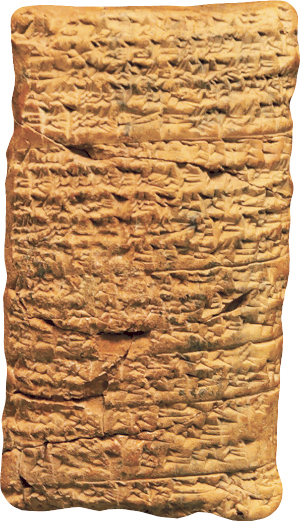God versus Idols (10:1–25)
Signs in the sky (10:2). The Israelites were not to fear the signs in the sky, that is, those that originate in the sun, the moon, and the stars. These heavenly bodies are part of God’s creation (cf. Gen. 1) and therefore under his sovereignty. But in general the ancient Near Eastern human being lived in fear of the “signs in the sky.” See sidebar on “Astronomy and Astrology in the Ancient World.”
They cut a tree … a craftsman shapes it with his chisel (10:3). The manufacture of idols was common in the ancient Near East. Images of deities were hewn out of stone, carved out of wood, modeled in clay, or cast in bronze. Some were four to ten inches high; others were life-size. Here Jeremiah refers to images chiseled out of wood and then overlaid with silver and gold and clothed in blue and purple. These idols were seen as more than merely representing a deity, but at the same time they were not identified wholly with the deity. The ancient Near Eastern person worshiped the deity they believed was present in the image, not the image itself.109
These statues or idols were lavishly decorated with gold and silver. Gold was the more valuable metal. It was either beaten with a hammer into thin sheets, since it is a relatively soft metal, or it was melted and cast into a given shape. Silver, by contrast, is hardly ever found pure; so that it had to be extracted from its ore by smelting with the help of bellows (see comment on 6:29). These idols were given life status; that is, one might say that the god became present in the idol through a specific ritual of consecration known as the opening or washing the mouth (see comment on 1:9).
Some of these deities were depicted anthropomorphically; others not. Nevertheless they all had to be cared for in terms of food, clothing, and other such needs. From the perspective of the prophet these idols have no power nor are they relevant to any real human need.110
Silver is brought from Tarshish and gold from Uphaz (10:9). The exact identification of Tarshish is still a matter of debate. Josephus, the first-century Jewish historian, identified Tarshish with Tarsus in Cilicia (modern Turkey). Others suggest Carthage in North Africa as a possible location, while yet others prefer Ezion Geber in the Red Sea area. Perhaps the strongest candidate is the Phoenician colony Tartessus in southern Spain, near Gibraltar.
A relatively recent discovery lends credence to the identification of Tarshish with the precious metal silver. Two new Hebrew ostraca were discovered that belong to the same time period (Iron Age), though of unknown provenance. One of them records the command of a king that silver from Tarshish be given to the house of Yahweh.111
The exact location of Uphaz is also unknown. Daniel 10:5 also mentions it as a source of gold. Some suggest that it could be Ophir, also mentioned as an important source of gold. Once again the discovery of an ostracon sheds light on this matter. An eighth-century B.C. sherd found at Tell Qasile (modern Tel Aviv) bears the following inscription: “Ophir gold to Beth-horon, 30 shekels.”112
Dressed in blue and purple (10:9). We cannot know the exact shade of these colors, but they appear to be particularly indicative of royalty and divinity. These two Hebrew terms are also used to describe the drapery of the tabernacle and temple (Exod. 26:1; 2 Chron. 2:7). Elsewhere these colors are associated with the wealthy and powerful of society. The dyes were quite expensive and most likely came from a shell or a mollusk that attached themselves to rocks on the Phoenician coast.113 The more inexpensive dyes came from vegetables.

Relief from the tomb of Maya showing work on statues
Keith Schengili-Roberts/Wikimedia Commons, courtesy of the Ägyptisches Museum, Berlin
Wind from his storehouses (10:13). The Babylonians attributed meteorological phenomena to the storm god Adad (see sidebar on “Astronomy and Astrology in the Ancient World”). The prophet states here that Yahweh is the only one responsible for all that happens in the atmosphere. The image Jeremiah uses is one used elsewhere in Scripture (Deut. 28:12; Ps. 33:7), where the primordial rain, lightning, snow, hail, and wind are in Yahweh’s storehouses. These meteorological elements are often unleashed by God’s breath (wind) either as divine blessing or divine judgment. They can also defeat Israel’s enemies. Note that “divine storehouses” is not a common imagery in the ancient Near East; this seems to be more a characteristic of a biblical worldview.
Haunt of jackals (10:22). See comment on 9:11.
